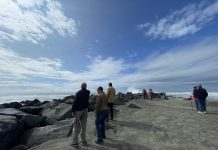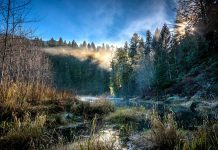In the early afternoon hours of Sunday, December 4, 1949, a 153-foot tall Douglas fir was cut down not far from Nooksack Valley High School.
The tree’s height and age were not particularly remarkable, but within a week’s time, the tree’s use would put it in newspapers from Hawaii to South Africa. A few days after being toppled, it would once again rise into the sky—this time in downtown Bellingham—as the tallest Christmas tree in the world.
Tall Trees and Jaycees
The idea of making Bellingham the best “Christmas City” in the country began with the city’s Junior Chamber of Commerce in 1948. The group, better known as the Jaycees, was full of young businessmen who wanted to publicize Bellingham and its commitment to holiday spirit.
By December 11, the Jaycees had announced their plans and located a Doug fir big enough to be the world’s tallest Christmas tree. It’s not clear what the existing record even was at the time, but the Jaycees wanted Bellingham to unequivocally establish one.
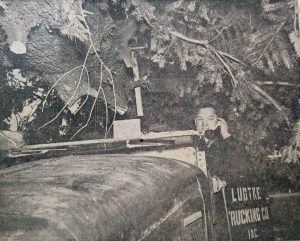
The nearly 100-year-old tree, located a quarter-mile from the Mount Baker Highway off Smith Road, was 134-feet-tall—equivalent to a 12-story building. Erecting it in the middle of downtown Bellingham would be, a Bellingham Herald article surmised, a “Paul Bunyan act.”
Slowly but surely, the tree was cut, lowered, and put onto a very long trailer, then slowly hauled into Bellingham, where it was erected December 14 near the intersection of Railroad Avenue and Chestnut Street. A crane and 10 logging trucks were needed to raise the tree into place, and it was lashed down with thick cables. It was decorated with 800 colored lights and topped with an eight-foot-tall star.
The tree was mentioned on CBS News Radio by famed broadcaster Edward R. Murrow, who grew up in Skagit County. The record-setting Christmas tree stood until January 2, 1949. When it was taken down, the arm of the crane tasked with holding most of its weight collapsed. Fortunately, no one was injured. The tree was then cut into 1,800 board feet of lumber and sold. Although the Jaycees had accomplished their goal, they decided to take things even further the next Christmas.
A Herculean Effort
By mid-November 1949, the Jaycees were once again in the Bellingham Herald, asking if any Whatcom or Skagit County residents knew of a potential Yule tree taller than the one from 1948. By November 29, they’d found it.
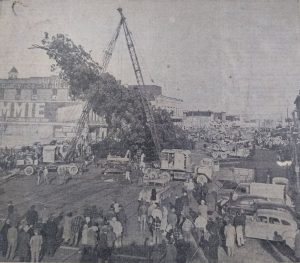
Located a quarter-mile west of Nooksack Valley High School, about 100 feet from a roadway on land owned by a deputy sheriff, a 153-foot-tall Douglas fir stood pointing into the sky. It was about 55 inches around, and its weight—likely more than 10 tons—could only be guessed at.
On Saturday, December 3, work crews comprised of more than a dozen Jaycee members, various loggers, high riggers, and truck drivers visited the tree, preparing for the next day’s felling. Led by supervising logger Glen Corning and high rigger Al Knowles, the men worked throughout the day. Sunday, December 4, just after lunch, the cutting began.
With a 20-mph northeast wind sweeping across the Sumas plains, Corning, Knowles, bow bucker John Riddle and logger W.J. Manthey sawed into the giant tree. Other workers were in their proper places to aid its slow descent to the ground; dozens of others showed up just to watch. Two power lines had to be cut, and telephone wires were lowered from their poles.
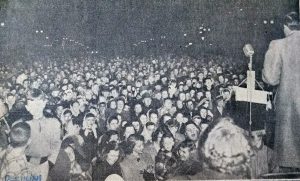
Cables were rigged from the big tree to two smaller trees, several tractors and a number of trucks, and a 23-ton crane helped lower the tree once it broke from its base. It was then put onto two Ludtke Trucking logging trucks arranged nose-to-tail, 100-feet apart. By 3:30 p.m., the tree began its slow, complicated journey to Bellingham. It left behind a crew of men who’d consumed 175 sandwiches, seven cakes, and seven gallons of coffee during work breaks.
‘In a Big Way’
Accompanied by the State Patrol and local power and telephone personnel, the two trucks proceeded carefully with the 145-year-old tree. Abner Ludtke drove the lead truck, with Frank Aubel piloting the rear. Ensconced in the middle of thick branches, Aubel had to receive instructions from Ludtke on an intercom telephone to know where he was going.
The tree’s route required roads to be cleared of other traffic, and in some cases, of brush, fences, power poles and electrical wires. In certain places, curves needed widening. The tree traversed several county roads before being parked overnight, and continued towards Ferndale on Monday until darkness fell. On the morning of Tuesday, December 6, the tree crossed a new Ferndale bridge over the Nooksack River, chosen because no other Whatcom County bridge could handle it.
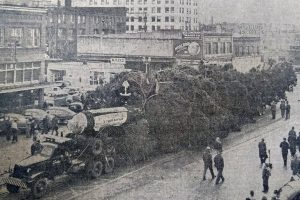
By mid-afternoon, the tree entered Bellingham via Northwest Avenue. It continued onto Broadway, and then up Holly Street until it reached Railroad Avenue. On top of the tree, waving to the gathered masses, rode Santa Claus himself—portrayed by local Italian restaurant owner Jerry Paolergio. Meanwhile, Herald photographer Jack Carver stood with his camera atop the Mason Building at the corner of Holly and Railroad, snapping a now iconic photo of the tree.
During the week, the tree was hoisted off the trucks and placed flat on pilings, where Jaycee members decorated it with 1,000 colored lights and a 15-foot-tall lighted cross at its tip. On the afternoon of Saturday, December 10, two cranes and 14 trucks—plus multiple rigging cables—lifted the tree upright, its butt sinking into an eight-foot space in the middle of the street.
On Tuesday, December 13, an official tree lighting ceremony drew nearly 1,000 people. At 4:50 p.m., Edward R. Murrow—in a live CBS News broadcast from New York City—spoke about the tree, his iconic voice pumped out over a public address system for those along Railroad Avenue. When Murrow pressed a button in New York, a switch was thrown and the 153-foot-tall tree lit up. It dwarfed a 110-foot-tall Christmas tree in Vancouver, B.C., and was twice as tall as New York City’s iconic Rockefeller Center tree. Murrow, in his radio broadcast, summed up Bellingham’s accomplishment succinctly: “Out in the Pacific Northwest,” he said, “they do things in a big way.”
What Goes Up
Pictures of and stories about the world-record Christmas tree made newsreels and newspaper across the globe. A man in Rome wrote a letter to Bellingham’s mayor about it, and a Deming woman won a trip to Chicago to talk about the tree on a radio program. The tree stood until January 7, 1950, when 12 logging trucks with steel cables lowered it until it could safely drop to the pavement.
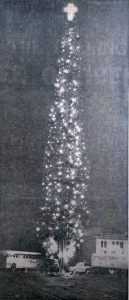
The tree was cut into pieces right on Railroad Avenue, eventually yielding nearly 3,000 feet of lumber. The wood was sold to anyone who wanted it, for whatever use they might have. Jeff Jewell, archivist at Whatcom Museum, says a handful of wood slices were carved into the shape of the United States; somewhere in the museum archives, he says, he has one.
Doubtful of finding another tree even taller in 1950, the Jaycees ended their “world’s tallest Christmas tree” shenanigans. That December, a 221-foot-tall Doug fir was erected at Seattle’s Northgate Shopping Center. According to Guinness World Records, it officially remains the tallest Christmas tree ever.
Today, Bellingham still has holiday decorations and tree lighting ceremonies, but nothing has ever approached the scale of what happened in 1948 and ’49. Jewell says Carver’s iconic image of the tree—which hangs in multiple Bellingham businesses alongside other local black and white photos—likely resonates with people today as a nostalgic reminder of wholesome, apolitical togetherness.
“It captures a time when the community got together and did things like this,” he says. “It also showed that the combined might of local merchants was sufficient enough to organize and sponsor such a thing. I think it’s a heart-warming photo.”
All photos by Jack Carver,
from December 7, 1949 and December 10, 1949 editions of the Bellingham Herald
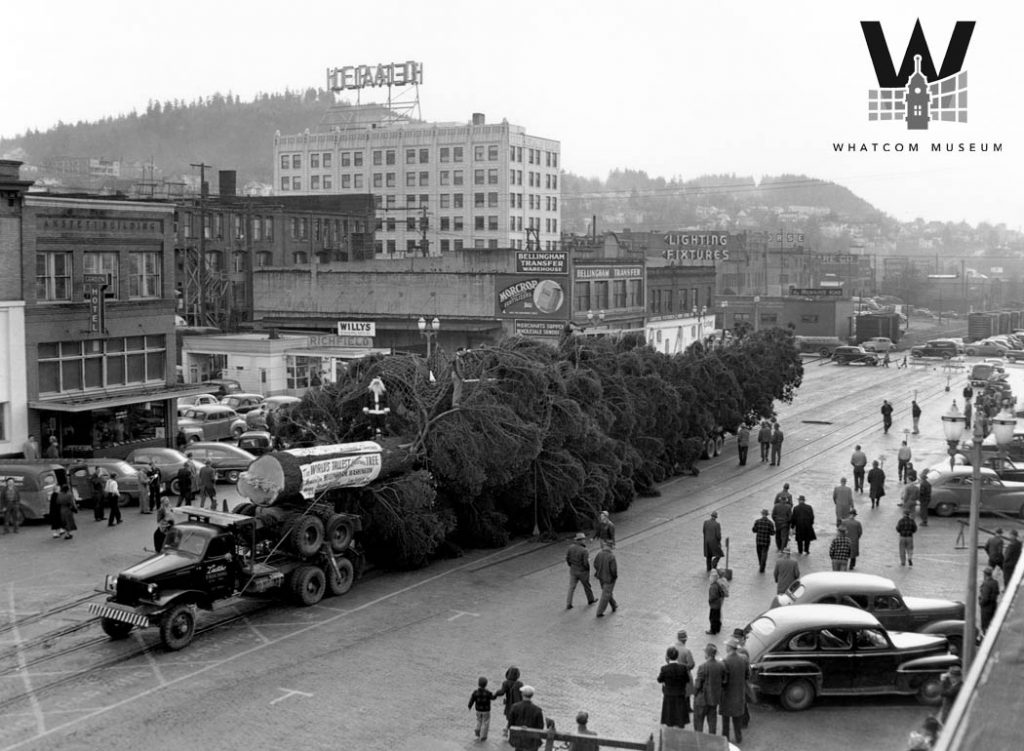
Featured photo by Jack Carver, Whatcom Museum #1995.14.70
















